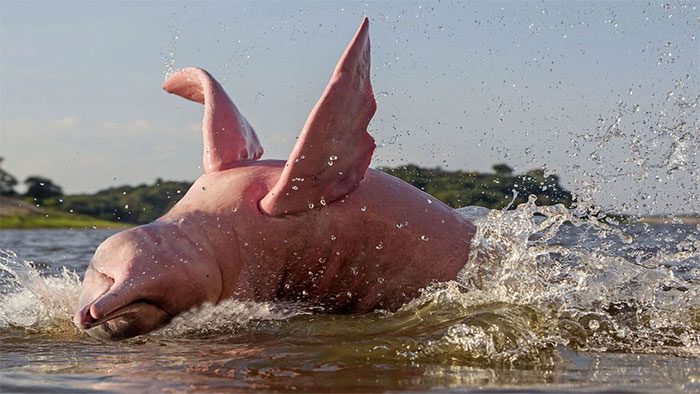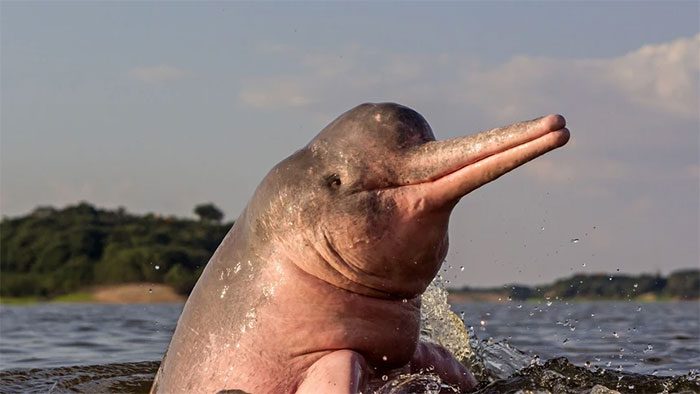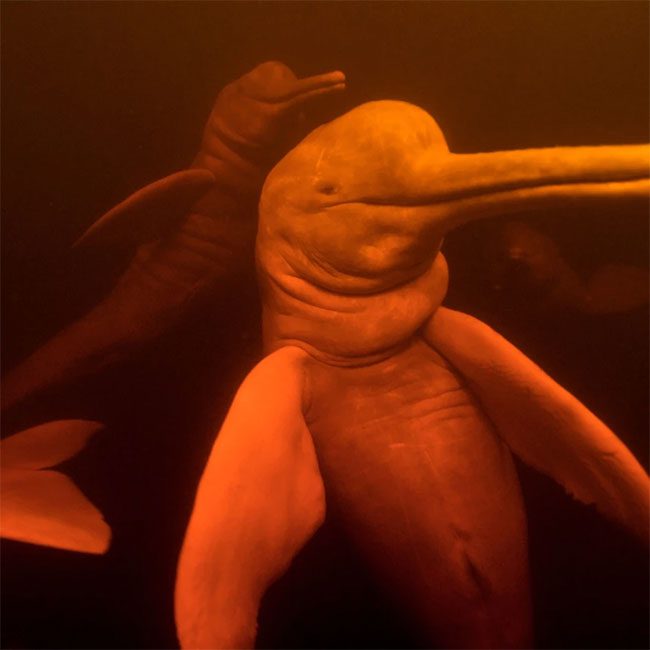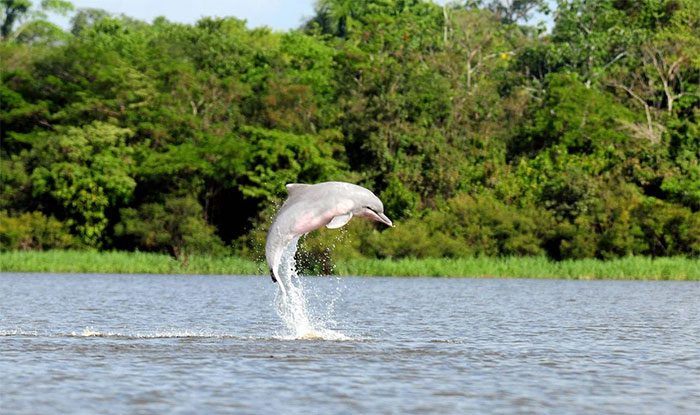The Amazon river dolphin, also known as Inia geoffrensis, is the most magnificent and vibrant member of the dolphin family. It can only be found in the murky waters of the Amazon River basin in South America.
Why Amazon River Dolphins are Pink
The Amazon river dolphin has a unique skin color and appearance that sets it apart from other dolphin species. The exact reason for this distinct coloration is not fully understood, but it is believed to be due to a combination of genetic factors, diet, and environmental influences.
One explanation for the pink color in this dolphin species is that their diet is rich in carotenoids – organic pigments found in fish and crustaceans that they consume. Carotenoids are known to contribute to the pink or orange coloration in certain bird species (like flamingos), fish, and reptiles, so it is possible that a similar mechanism is responsible for the pink hue in dolphins.

Carotenoids are the most widely distributed pigments in nature and are also found in some species of fungi.
“This freshwater dolphin species is the largest river dolphin still existing on the planet. They are born gray, and the pink color gradually appears as they mature. Their final coloration will be influenced by many factors including behavior, diet, and the proximity of capillaries to the skin,” explains biologist and author Helen Pilcher.
Additionally, a combination of genetic and environmental factors may play a role. Some studies suggest that the pink coloration may be related to the thickness of the skin, which could affect the amount of blood flowing through it. Hormones, stress, or other factors may also contribute to the coloration of the Amazon river dolphin.

An Amazon river dolphin jumping in a flooded forest in Rio Negro, Brazil. Their short paddle-like flippers and strong, long tail make them well-suited for navigating through narrow and shallow waterways, allowing them to catch fish and evade predators in the Amazon’s waters.
What Do Amazon River Dolphins Look Like?
In addition to their distinctive pink coloration, Amazon river dolphins have a robust body with a tapered shape and long snout. They possess sharp teeth in the front for catching prey and flatter teeth in the back that function similarly to human molars.
They have a prominent, bulging forehead, referred to as the “melon,” which houses the dolphin’s echolocation system. Amazon river dolphins can even change the shape of their melon, a feature researchers believe may help them adjust the direction, size, and/or frequency of their echolocation pulses.

While dolphins are often associated with the ocean, our planet has five species that have adapted to the freshwater of some major rivers, including the tucuxi dolphin, Ganges river dolphin, Indus river dolphin, Irrawaddy dolphin, and the Amazon river dolphin.
Like most dolphin species, they also have a sleek, elongated body designed to glide through water and leap above the surface. Their long, powerful tail is used for propulsion and steering. Similarly, their eyes are relatively small and are often thought to have poor eyesight, but in low light conditions, their pupils can adapt to dilate, allowing them to see better in the murky waters of the Amazon.
However, unlike other dolphin species, the vertebrae of the Amazon river dolphin are not fused, which means they can turn their heads from side to side.
The flippers of the Amazon river dolphin are quite wide, capable of moving independently from one another, making them very suitable for navigating obstacles and complex currents of the river, or for chasing prey in the flooded forest. However, they are not designed for achieving super-fast speeds, especially when compared to their ocean-living relatives.

The Amazon river dolphin, also known as boto, is found throughout the Amazon and Orinoco river basins in South America, spanning Brazil, Peru, Venezuela, Bolivia, Ecuador, and Guyana.
Adult Amazon river dolphins typically swim at speeds of 8-13 km/h, sometimes reaching speeds of up to 24 km/h for short distances.
Despite their slower speeds, Amazon river dolphins have a high degree of maneuverability compared to ocean-dwelling dolphins, as the Amazon can create complex currents and various obstacles that need to be avoided.
Amazon river dolphins have a flexible and varied diet – perhaps partly due to their two types of teeth – and specific types of prey can vary based on factors such as location, season, and available food sources.
They primarily feed on various fish found in the Amazon River and its tributaries. Some fish species commonly consumed by Amazon river dolphins include piranha, catfish, and tetra.
In addition to around 50 species of fish, Amazon river dolphins can also eat crustaceans such as crabs and shrimp, as well as small turtles and freshwater mollusks. They use their echolocation abilities to locate prey—emitting high-pitched clicks and listening for the echoes that bounce back through the often murky water. These echoes are received by the dolphin’s lower jawbone.

The Amazon river dolphin is the largest freshwater dolphin in the world. Adult males can grow up to 2.7 meters long and weigh up to 180 kg. Adult females are typically slightly smaller, averaging around 100 kg.
In fact, the Amazon river dolphin was granted international protection status in 2018 and is listed as a vulnerable species by the International Union for Conservation of Nature (IUCN).
Habitat degradation due to activities such as deforestation, mining, dam construction, and changes in water flow has disrupted the dolphin’s ecosystem and reduced their available food sources. Pollution from agricultural runoff and industrial waste has further degraded the water quality of the Amazon River.
As a slow-reproducing and long-living mammal, the Amazon river dolphin is particularly vulnerable to these threats and requires urgent conservation efforts to ensure their survival.




















































